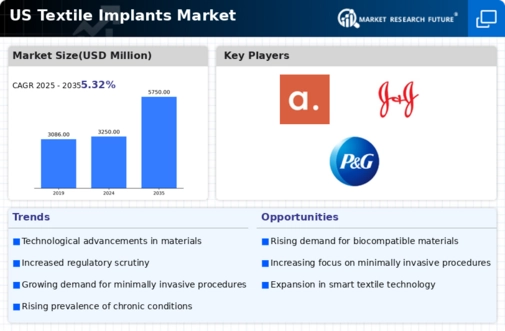Rising Healthcare Expenditure
The textile implants market is experiencing growth due to the increasing healthcare expenditure in the US. As healthcare spending rises, which reached approximately $4.1 trillion in 2023, there is a corresponding increase in demand for advanced medical technologies, including textile implants. This trend is driven by the need for improved patient outcomes and the adoption of innovative surgical techniques. Healthcare providers are increasingly investing in high-quality textile implants to enhance surgical procedures, which is likely to propel market growth. Furthermore, the aging population in the US, which is projected to reach 80 million by 2040, is expected to drive demand for textile implants, as older individuals often require surgical interventions. Thus, the rising healthcare expenditure is a significant driver for the textile implants market.
Expansion of Surgical Applications
the textile implants market is expanding due to the broadening range of surgical applications. As surgical techniques evolve, the use of textile implants is becoming more prevalent across various specialties, including orthopedics, cardiology, and reconstructive surgery. This diversification is driven by the increasing recognition of the benefits that textile implants offer, such as improved tissue integration and reduced rejection rates. For instance, the orthopedic segment is expected to account for a substantial share of the market, driven by the rising incidence of sports injuries and degenerative joint diseases. The textile implants market is projected to grow at a CAGR of 6.8% through 2030, reflecting the increasing adoption of textile implants in diverse surgical applications. This expansion is likely to create new opportunities for manufacturers and healthcare providers alike.
Increased Focus on Personalized Medicine
The textile implants market is being driven by the growing emphasis on personalized medicine in the US healthcare system. As healthcare providers strive to tailor treatments to individual patient needs, the demand for customized textile implants is on the rise. This trend is supported by advancements in materials science and manufacturing techniques, allowing for the creation of implants that are specifically designed for unique anatomical and physiological characteristics. The market for personalized medical devices, including textile implants, is projected to reach $50 billion by 2027. This focus on personalized medicine not only enhances patient outcomes but also aligns with the broader shift towards patient-centered care in the healthcare industry. Consequently, the textile implants market is likely to see sustained growth as it adapts to these evolving healthcare paradigms.
Technological Innovations in Textile Engineering
Technological advancements in textile engineering are playing a crucial role in shaping the textile implants market. Innovations such as 3D printing and bioengineering are enabling the development of customized textile implants that meet specific patient needs. These advancements not only enhance the functionality of implants but also improve biocompatibility and reduce the risk of complications. For instance, the introduction of smart textiles that can monitor physiological parameters is gaining traction in the market. the textile implants market will grow at a CAGR of 7.5% from 2025 to 2030, driven by these technological innovations. As manufacturers continue to invest in research and development, the market is likely to witness the emergence of novel textile implant solutions that cater to diverse medical applications.
Growing Awareness of Minimally Invasive Procedures
The increasing awareness and preference for minimally invasive surgical procedures are significantly influencing the textile implants market. Patients and healthcare providers are increasingly recognizing the benefits of such procedures, including reduced recovery times and lower risk of complications. This shift in preference is prompting surgeons to adopt textile implants that facilitate minimally invasive techniques. According to recent studies, minimally invasive surgeries have been associated with a 30% reduction in hospital stays compared to traditional methods. As a result, the demand for textile implants that support these procedures is expected to rise. The textile implants market is likely to benefit from this trend, as healthcare providers seek to enhance patient satisfaction and outcomes through innovative surgical solutions.

















Leave a Comment